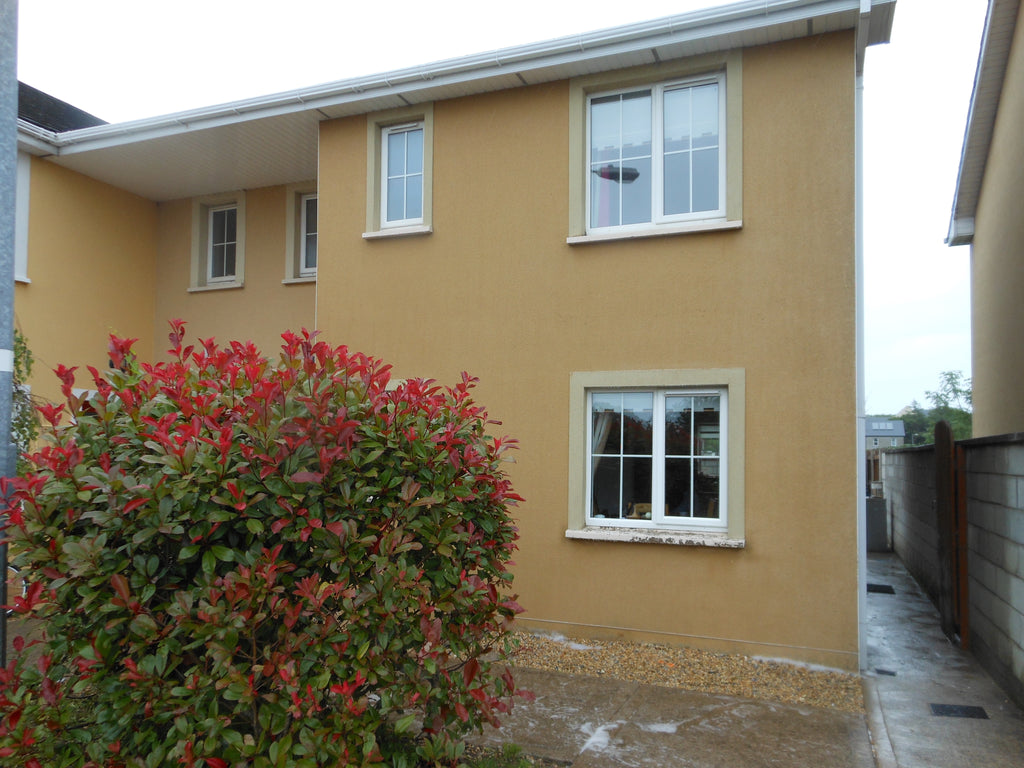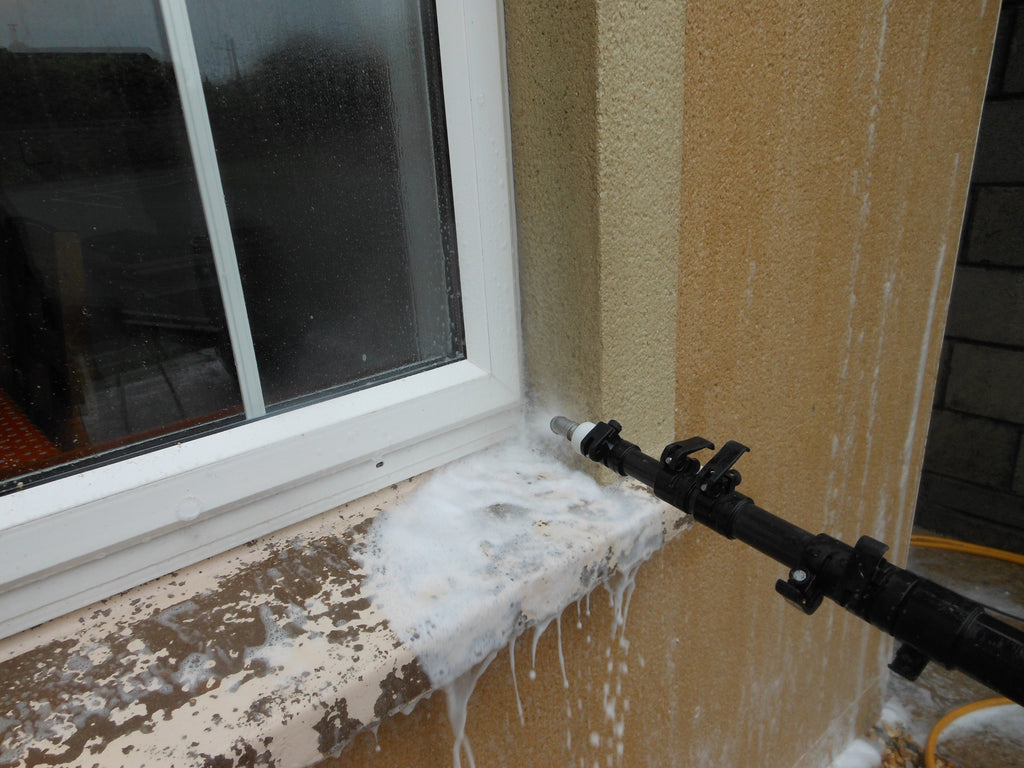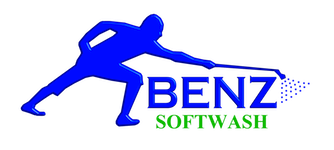Softwashing Render

CLICK HERE TO EXPLORE THE BENZ HOW-TO MANUAL FOR
"PROFESSIONAL RENDER SOFT WASHING"
The photo above shows some typical colonisation of algae, lichen, fungus and mould growing on through-coloured renders. The house on the right has been treated with Benz Lightning Cleanze and Bio Cleanze.
Soft washing various types of wall render
Before starting work it is important to identify the type of render to be treated, This enables you to choose the most effective treatment system and to tell your customer what will be a reasonable result to expect.
Click the links below to learn techniques for soft washing different types of render:
- What's the most effective way to softwash wall render?
- Does Lightning Cleanze produce hydrochloric acid on render? (Video)
- How can you prevent marks remaining on render after softwashing? (Video)
- How to quickly & easily remove rust stains from render with Benz Oxy Cleanze
- What are the most effective ways to softwash red algae stains from wall render?
- What's the fastest and least expensive way to learn about softwashing render?
- How to remove rust stains from painted render (video)
-
How to softwash sand and cement render
- Would I use "Through Colour Render" on my own property? (video)
- Softwashing painted sand & cement render with Benz Bio Cleanze (video)
- How to soft wash pebble dash (dry dash) wall render with Bio Cleanze
Softwashing render cleaning systems
System 1
Apply Benz Lightning Cleanze. This is a fast-acting solution that rapidly removes 95-100% of staining from the rendered surface. It offers the near-immediate cleaning effect many customers want.
Lightning Cleanze can be a stand-alone softwash solution, or it can be followed up with a post-treatment of Bio Cleanze, which will continue cleaning deeper into the substrate for up to a year. It also offers long-term protection from re-colonisation. (see System 3 below)
Average Levels of Biological Growth – red, green, yellow and light black staining: Apply treatment > rinse. Apply second treatment, brushing in gently with a reasonably soft brush > rinse.
Green stains will usually be gone within an hour.
Red stains will turn pink and disappear in 4-24 hours.
Black stains will normally disappear within two hours after a second treatment. If not, repeat until they have turned a light brown. They will keep fading over time, normally less than 24 hours.
Extreme levels of biological growth – very heavy black staining: Apply treatment > rinse. Apply second treatment, brushing in gently with a reasonably soft brush > rinse. Apply third treatment (if required) > rinse.
Quick tip: Treating the affected area with a topical application of Benz Tornado Cleanze is another, often simpler, way to remove heavy black staining.
Tornado Cleanze may need to be used where there's been a constant flow of water down the render. For example, where an overflow pipe or gutter has been leaking or there is a ledge or overhang. In these areas there may be water marks ingrained deep into the surface that cannot be fully removed and will remain after cleaning.
Tornado Cleanze is a gel that sticks to the render, enabling a longer activation time.
It is also a highly effective way to treat blackened window sills and coping stones.
System 2
Apply Benz Bio Cleanze. This will kill the algae, lichen fungus and mould spores and will provide a degree of ongoing residual biocide protection. This is a slower process that shows results between 48 hours and two weeks, and the surfaces will continue to naturally self-cleanse over the 12 months following treatment.
Bio Cleanze can be applied as a stand-alone softwash solution, or it can be a post-treatment after initial cleansing with Lightning Cleanze. (see System 3 below)
This biocide is a popular and well-established softwash system that is quick to apply and gives excellent results on red, green, yellow and light black staining. It is the quickest and therefore least costly soft washing process.
Watch this quick video on the process (note that the video refers to "Biocidal Wash", which was the old name for Bio Cleanze.
System 3
Benz "Clean & Maintain" softwash systems. This is the optimum softwash treatment for customers who want the very best.
First clean the surface with Lightning Cleanze. Then, if necessary, apply Tornado Cleanze to areas of exceptionally ingrained black and red stains. This gives the "instantly clean" effect that many customers want.
Then rinse and post-treat with Bio Cleanze to offer residual biocide protection and an exceptionally powerful ongoing cleaning effect over up to 12 months. Bio Cleanze will kill any remaining spores that were hiding deep into the substrate and will remove any remaining staining.
System 4
High pressure (power) jet washing. DON'T DO THIS – because a high pressure jet can easily damage the render and leave unsightly "stripes" on the surface.
Quick tip: KRend suggest cleaning their render with a very light jet wash when absolutely necessary. In our experience this should be avoided whenever possible, which is almost all of the time.
We recommend using Systems 1, 2 or 3 depending on the needs of a particular job and the preferences of your customer. You may decide to use different systems on different elevations depending on the type of staining and degree of colonisation. What your customer is willing to pay is obviously another factor to take into account when determining which softwash system to use.
Click here to learn about the fully illustrated Benz Render softwashing how-to manual
The manual is a comprehensive paperback guide to the cleanng and maintenance of render, written specifically for soft washing professionals.
Health & safety warning: Using products with high levels of available chlorine from strong dilutions of sodium hypochlorite may harm some renders – and most especially will seriously damage rubber and metal fittings around windows and doors. They also present extremely dangerous long-term health hazards for the operator, customers, the general public, children and animals.
Benz Lightning Cleanze in contrast is safe when used according to the guidelines on the product label and on this website.
How to rinse Lightning Cleanze from wall render
We use a zero degree round tip lance for rinsing, which allows us to reach the gable ends of houses from the ground.
A 6 foot lance or telescopic pole makes the work easier. As the operator directs the jet progressively down the wall he can easily step back to reduce the pressure on the surface. Aim for a little over hosepipe pressure on the surface.Click here to watch Ben in action using the above equipment (near the end of the video at 20:50 minutes)
Quick tip: Lower elevations can also be rinsed with a wide angle nozzle. Orifice size will depend of the output of the pressure washer. For example, a 12 Lpm, 2500 Psi machine will need a 3mm orifice for the zero degree tip.
Should I apply Benz biocides to dry render, or wet it first?
Whenever possible, apply our biocides to a dry surface. An exception is that on a very hot day, especially on an elevation facing the Sun, it can be a good idea to hose down the surface to cool it. This will reduce the possibility of the soft wash biocide "boiling-off" before it has a chance to work.
It will also minimise the possibility of the very dry surface absorbing the biocide before it has a chance to work on the biological colonisation, the majority of which tends to be on the surface of the render.
The problem customers want us to solve ...

First Softwash System: Applying Benz Lightning Cleanze
Use a low pressure spray. An example of a set up to achieve this is a Benz 10 Softwash Spray Nozzle, a carbon fibre or carbon composite water fed pole, and a 5-8 litres/minute 12v pump which will deliver 1-2 litres/minute at the nozzle tip.
Apply to the surface at between 5-10:1 dilution, depending on the severity of the staining. If you are new to soft washing, start at 5:1 and gradually increase dilution as you get to know how the different types of staining are best cleaned from the various rendered surfaces.

When you've sprayed the first elevation, change from a spray tip to a brush. Then gently brush-in to ensure maximum penetration of the biofilm (the layer of biological growth that causes the staining and "dirty" appearance). You will need a relatively low flow of chemical through the brush to soak the render.
After 30-60 minutes the cleaning effect of Lightning Cleanze will already be noticeable. To complete the work a second application may be necessary.
The importance of rinsing
Always thoroughly rinse Lightning Cleanze from the surface being treated after allowing 30-60 minutes for the cleaning action to take effect. This ensures the salts left behind by the breakdown of chlorine, which could leave stains if not rinsed properly – or potentially damage the surface if left – are removed.
Also, we advise rinsing between applications of Lightning Cleanze. Rinsing off the previous coating of Lightning Cleanze removes the "debris" from the pores of a porous surface, thus allowing subsequent applications to penetrate more deeply and clean more effectively.
We recommend gently brushing each application of Lightning Cleanze into the surface, so that it penetrates the biological growth to the maximum depth and thus increases the effectiveness of the treatment.
Gently brush or "massage" in Lightning Cleanze – especially into badly stained areas of the surface – using a suitable water fed brush. We use the Gardiner cladding brush and find it works well.
After another 30-60 minutes the results will be dramatic and you can complete the job by thoroughly rinsing the surface.
Quick tips:
- Over aggressive brushing may cause a very slight discolouration of coloured render and could even damage the render itself. The discolouration will fade over time through the effect of natural weathering.
- Badly infected (stained) surfaces will need Lightning Cleanze to be applied at 5:1 dilution.
- Sometimes, in rare cases, the microbiological growths can damage the render by holding moisture and excreting acids. The deep stains will fade over time with natural weathering but the surface may never fully recover.
- Some renders suffer from efflorescence (the migration of a salt to the surface of a porous material, where it forms a coating), which can be exposed once the staining is removed. Usually this is only an outer cosmetic disturbance but can sometimes can indicate an internal structural weakness.
Treat all surrounding surfaces
It is important to treat all surrounding surface areas that can harbour live spores, which will cause staining to return. For example, wall capping cement where algae spores thrive and then run down the wall.
Also treat adjacent footpaths, as spores can blow up from an untreated path onto the walls of the property, meaning the results of your work will not last as long.
Also treat window sills and corners of inside reveals.
Clean the windows
It's always good practice to clean the customer's windows after spraying as they will be covered with Lightning Cleanze. This won't do any harm but customers appreciate having their windows left sparkling clean, like the rest of their property.
Second Softwash System: Apply Benz Bio Cleanze
Spraying only with Bio Cleanze is less labour intensive but, depending on the weather, results may take 48 hours to two weeks to show up.
Use the smaller 6.5 nozzle to increase the output pressure, thus enabling good penetration of the biocide into the biofilm. This ensures the treatment kills all algae, lichen, fungus, and mould spores. A higher flow rate pump can be used with Bio Cleanze to make application quicker.
Another advantage of the 6.5 nozzle is that it limits spray drift because of the precision engineering of the internal components in the cone spray tip.
Simply spray the whole elevation with the solution at 30:1 dilution.
Ensure the surface is saturated.
Brush in a second application after 15 minutes to deal with the black staining around window sills, reveals, and so on. (or treat with Tornado Cleanze)
CLICK HERE TO READ "TRADE TIPS" POSTS THAT FOCUS ON SOFT WASHING SPECIFIC TYPES OF RENDER
CLICK HERE TO WATCH "HOW-TO SOFT WASH RENDER" VIDEOS
From this ...

To this ...

Back to top
Photography
We took all the photos on the same day in similar lighting conditions. We did not use photoshop or in any way alter the images to increase their dramatic effect. What you see is what you would see if you were to visit the property.
Drainage systems
It is important to protect our environment by minimising run-off into sewers and drains. Run-off can be kept to minimum or zero by using Benz softwash spray nozzles along with skilful spray and brush control techniques.
Run-off should never be allowed to enter surface drains and any drainage system leading to rivers, fish ponds, soak-aways, reed beds and septic tanks.
Run-off should only be directed into foul water drains*.
If some run-off to the vicinity of surface drains is unavoidable, block the drains and/or gutter downpipes until application has been concluded. Protect the drains and contain the run-off by using "dams". Then remove the run-off from site using suction equipment, or brush into a foul drain.
*Click here to learn how to work with drains, waterways and dams
A practical demonstration
It is not possible for us to show everyone individually what we've found to work best when it comes to softwashing application techniques. So we made the videos below to demonstrate what we've found through experience to be the best practices when softwashing render:
- Click here to learn about soft washing specific types of render
- Click here to watch our softwashing render how-to videos
Click the links below to explore Benz soft wash cleaning chemicals & equipment:
- Bio Cleanze
- Lightning Cleanze
- Tornado Cleanze
- Oxy Cleanze
- Perma Cleanze
- Window Cleanze
- Softwash Nozzles
- Roof moss scrapers
- All Benz Softwash equipment
- The Benz full illustrated softwashing how-to Manual
Click here to get more practical soft washing how-to tips
How to find answers to most soft washing questions: Simply enter a relevant "keyword" or short phrase (e.g. keyword for above link = "how to") into our in-site Search Engine (the magnifying glass icon on main menu)
You can order Benz softwash chemicals & equipment online or by phone:
GB (England, Scotland, Wales)
Phone: 0800 70 74 222
Online: www.benzsoftwash.co.uk
Ireland and other countries
Phone: 00353 214 622 978
Online: www.benzsoftwash.com
Lines open Monday - Friday, 9am – 5pm
Please note: The above numbers are for orders only (click here for tech support)









